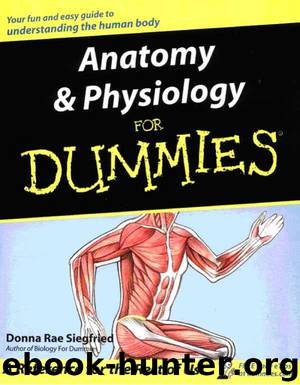Anatomy And Physiology For Dummies by Unknown

Author:Unknown
Language: eng
Format: epub
Tags: Medical Sciences
Part III: Feed and Fuel: Supply and Transport
microscopic blood spaces called sinusoids. Blood from the interlobular veins and arteries circulates through the sinusoids with food and oxygen for the liver cells, picking up materials along the way. The blood then enters the intralobular veins, which carry it to the sublobular veins, which empty into the hepatic vein, which leads to the inferior vena cava. Bile secreted from the liver cells is carried by biliary canaliculi (bile capillaries) to the bile ducts and then to the hepatic ducts.
Considering the number of vital roles the liver plays, the complexity of that process isn’t too surprising. Among the liver’s various functions are
u* Production of blood plasma proteins including albumin, antibodies to fend off disease, a blood anticoagulant called heparin that prevents clotting, and bile pigments from red blood cells, the yellow pigment bilirubin, and the green bile pigment biliverdin
^ Storage of vitamins and minerals as well as glucose in the form of glycogen
Conversion and utilization through enzyme activity of fats, carbohydrates, and proteins
^ Filtering and removal of nonfunctioning red blood cells, toxins (isolated by Kupffer cells in the liver) and waste products from amino acid breakdown, such as urea and ammonia
Unfortunately, a number of serious diseases can damage the liver. The hepatitis virus inflames the gland, and cirrhosis caused by repeated toxic injury (often through alcohol or other substance abuse) destroys Kupffer cells and replaces them with scar tissue. Also, painful gallstones can develop when cholesterol clumps together to form a center around which the gallstone can form.
Pancreas
Equally important, though not as large as the liver, the pancreas looks like a roughly 7-inch long, irregularly shaped prism. It has a broad head lodged in the curve of the duodenum. The head is attached to the body of the gland by a slight constriction called the neck, and the opposite end gradually tapers to form a tail. The pancreatic duct extends from the head to the tail, receiving the ducts of various lobules that make up the gland. It generally joins the common bile duct, but some 40 percent of humans have a pancreatic duct and a common bile duct that open separately into the duodenum.
Uniquely, the pancreas is both an exocrine gland, meaning that it releases its secretion externally either directly or through a duct, and an endocrine gland, meaning that it produces hormonal secretions that pass directly into the bloodstream without using a duct. However, most of the pancreas is devoted to being an exocrine gland secreting pancreatic juices into the duodenum. The endocrine portion of the gland secretes insulin vital to the control of sugar metabolism in the body through small, scattered clumps of cells known as islets of Langerhans. Because it contains sodium bicarbonate, pancreatic juice is alkaline, or base, with a pH of 8. Enzymes released by the pancreas act upon all types of foods, making its secretions the most important to digestion. Its enzymes include pancreatic amylase, or carbohydrate enzymes; pancreatic lipase, or fat enzymes; trypsin, or protein enzymes; and nuclease, or nucleic acid enzymes.
Download
This site does not store any files on its server. We only index and link to content provided by other sites. Please contact the content providers to delete copyright contents if any and email us, we'll remove relevant links or contents immediately.
Whiskies Galore by Ian Buxton(41534)
Introduction to Aircraft Design (Cambridge Aerospace Series) by John P. Fielding(32892)
Rewire Your Anxious Brain by Catherine M. Pittman(18315)
Craft Beer for the Homebrewer by Michael Agnew(17936)
Cat's cradle by Kurt Vonnegut(14763)
Sapiens: A Brief History of Humankind by Yuval Noah Harari(13993)
Leonardo da Vinci by Walter Isaacson(12807)
The Tidewater Tales by John Barth(12398)
Underground: A Human History of the Worlds Beneath Our Feet by Will Hunt(11840)
Thinking, Fast and Slow by Kahneman Daniel(11798)
The Radium Girls by Kate Moore(11624)
The Art of Thinking Clearly by Rolf Dobelli(9919)
A Journey Through Charms and Defence Against the Dark Arts (Harry Potter: A Journey Throughâ¦) by Pottermore Publishing(9141)
Mindhunter: Inside the FBI's Elite Serial Crime Unit by John E. Douglas & Mark Olshaker(8707)
Tools of Titans by Timothy Ferriss(7818)
Wonder by R. J. Palacio(7745)
Turbulence by E. J. Noyes(7704)
Change Your Questions, Change Your Life by Marilee Adams(7381)
Nudge - Improving Decisions about Health, Wealth, and Happiness by Thaler Sunstein(7247)
